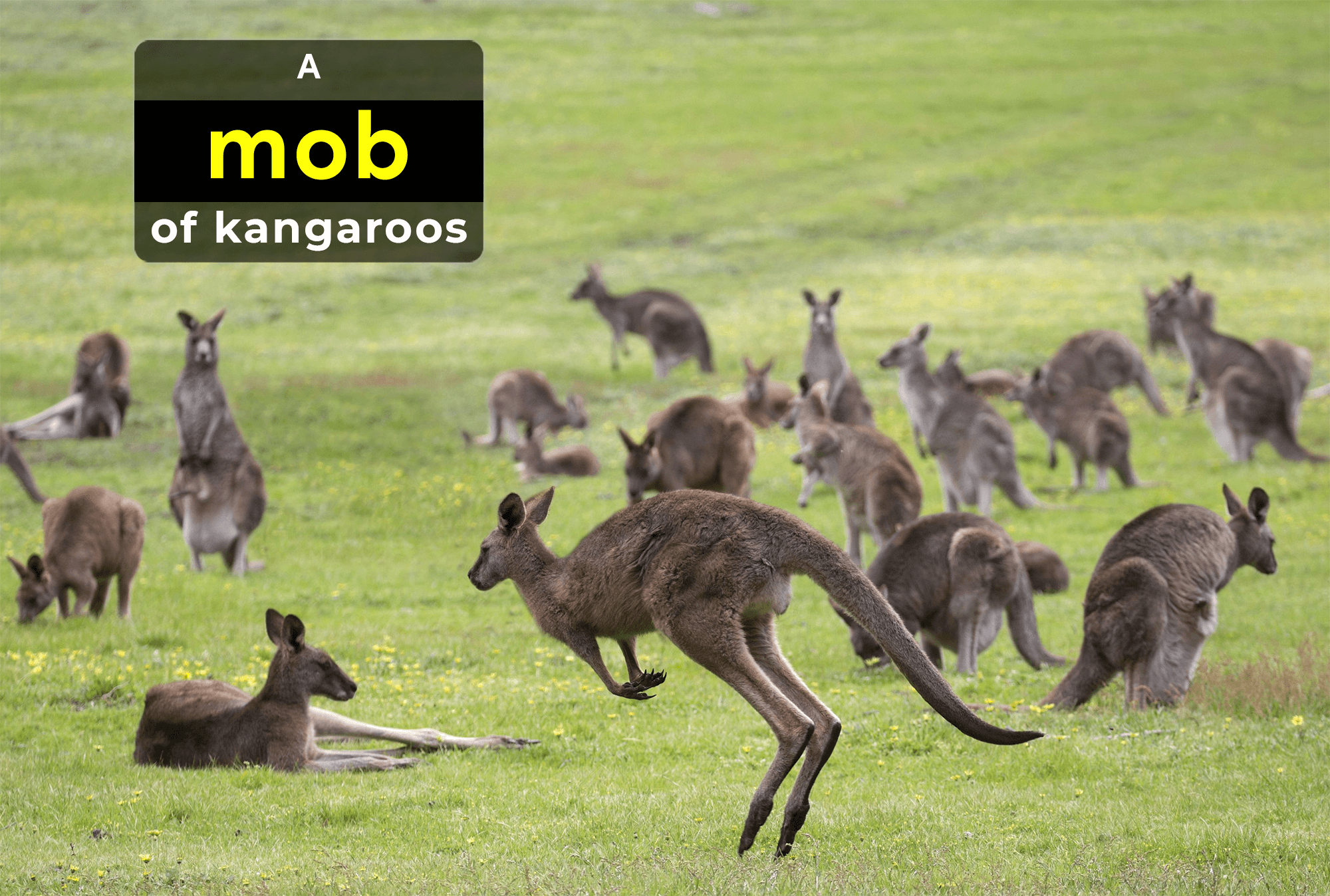What Are The Collective Nouns For Kangaroos? The Ultimate Guide
Alright folks, let’s dive right into it. If you’ve ever wondered about the collective nouns for kangaroos, you’ve landed in the right place. These amazing creatures aren’t just hopping around in the wild; they’ve got some pretty cool group names that make them even more fascinating. So, if you're curious about how kangaroos organize themselves in the outback, this article has got you covered. Let’s get started, shall we?
Now, why should you care about collective nouns for kangaroos? Well, it’s not just about the words themselves—it’s about understanding the behavior, culture, and social structure of these incredible animals. Kangaroos aren’t just random creatures hopping around aimlessly. They have a system, a way of life, and their collective nouns reflect that. Think of it as a peek into their world, a glimpse into the way they interact and thrive in the wild.
And hey, who doesn’t love learning something new, right? Whether you’re a wildlife enthusiast, a trivia lover, or just someone looking to impress their friends with fun facts, knowing the collective nouns for kangaroos can be your ticket to becoming the life of the party. So, let’s hop into it and explore the fascinating world of kangaroo groups!
- Kannada Movierulz New 2025 Your Ultimate Guide To The Latest Kannada Film Scene
- Unveiling The Truth Behind Leaked Mms Viral Videos
Why Do We Need Collective Nouns for Kangaroos?
First things first—what exactly is a collective noun? Simply put, it’s a term used to describe a group of animals, people, or objects. For kangaroos, these terms go beyond just naming a group; they often reflect the behavior and characteristics of the animals themselves. It’s not just about saying “a bunch of kangaroos”; it’s about understanding how they live, interact, and support each other in the wild.
For example, did you know that kangaroos are incredibly social animals? They live in groups called mobs, which we’ll dive deeper into later. These mobs aren’t random gatherings; they have a structure, a hierarchy, and even rules. Understanding their collective nouns gives us insight into their social dynamics and helps us appreciate these magnificent creatures even more.
The Importance of Collective Nouns in Wildlife Studies
Collective nouns aren’t just fun words to throw around at parties; they play a significant role in wildlife studies. Scientists and researchers use these terms to better understand animal behavior, social structures, and even conservation efforts. By studying how kangaroos form mobs, for instance, we can learn more about their habitat needs, migration patterns, and the challenges they face in the wild.
- Stream It Big Download Bollywood Movies In Hd Mkv 480p 720p 1080p In 2023
- Aagmaa Unlocking The Mysteries Of A Rising Phenomenon
Moreover, collective nouns can also help in identifying different species and subspecies of kangaroos. Not all kangaroos are the same, and their group names can sometimes vary depending on the species. This adds another layer of complexity and intrigue to the world of kangaroo collective nouns.
The Most Common Collective Noun for Kangaroos: Mob
Alright, let’s get to the good stuff. The most common collective noun for kangaroos is “mob.” Yes, you heard that right—a group of kangaroos is called a mob. But why mob, you ask? Well, it’s not because they’re into organized crime or anything like that (although that would be an interesting twist). The term “mob” actually refers to the way kangaroos move together in a coordinated manner, much like a mob of people moving through a crowded street.
Mobs can vary in size, but they typically consist of anywhere from 10 to several hundred kangaroos. These groups are usually led by a dominant male, known as a boomer, who keeps the peace and ensures everyone stays safe. Females, or flyers, and their joeys (baby kangaroos) make up the rest of the mob, creating a tight-knit community that works together to survive in the harsh Australian outback.
Other Collective Nouns for Kangaroos
While “mob” is the most well-known collective noun for kangaroos, there are a few others that you might find interesting:
- Herds: In some regions, particularly in areas where kangaroos are more spread out, they might be referred to as herds. This term is more commonly used for larger animals like cattle or deer, but it can also apply to kangaroos in certain contexts.
- Troops: Similar to mobs, troops are another term used to describe groups of kangaroos. This term is often used interchangeably with mobs, but it can also refer to smaller, more tightly-knit groups.
- Courts: Believe it or not, some kangaroo groups are referred to as courts. This term is usually used in more formal or scientific contexts and might refer to specific behaviors or interactions within the group.
These terms might seem interchangeable, but they each carry their own nuances and meanings. Whether you call them mobs, herds, troops, or courts, the important thing is that kangaroos are social creatures that thrive in groups.
The Social Structure of Kangaroo Mobs
Now that we’ve covered the collective nouns for kangaroos, let’s take a closer look at the social structure of these fascinating groups. Kangaroo mobs are not just random gatherings of animals; they have a complex hierarchy and social system that ensures their survival in the wild.
At the top of the hierarchy is the dominant male, or boomer, who leads the mob and protects its members from predators and other threats. Below him are the females, or flyers, who are responsible for raising the joeys and maintaining the social bonds within the group. Young males, known as bouncers, often hang around the edges of the mob, waiting for their chance to challenge the dominant male and take over leadership.
How Kangaroo Mobs Communicate
Communication is key in any social group, and kangaroo mobs are no exception. Kangaroos use a variety of methods to communicate with each other, including vocalizations, body language, and even scent marking. For example, when a kangaroo senses danger, it will thump its powerful hind legs on the ground to warn the rest of the mob. This thumping sound can be heard from a great distance, allowing the entire group to react quickly and stay safe.
Body language also plays a crucial role in kangaroo communication. From subtle tail movements to aggressive posturing, kangaroos use their bodies to convey everything from affection to aggression. This complex system of communication helps maintain harmony within the mob and ensures that everyone knows their place in the hierarchy.
Interesting Facts About Kangaroo Mobs
Ready for some fun facts about kangaroo mobs? Here are a few things you might not know:
- Kangaroo mobs can cover vast distances in search of food and water, sometimes traveling up to 20 miles in a single day.
- Female kangaroos can delay the development of their joeys if conditions are unfavorable, ensuring that their offspring have the best chance of survival.
- Male kangaroos engage in boxing matches to establish dominance, using their powerful hind legs and tails to deliver powerful blows.
- Kangaroo mobs are incredibly adaptable, able to thrive in a variety of environments from arid deserts to lush grasslands.
These facts highlight the resilience and adaptability of kangaroo mobs, making them one of the most fascinating animal groups in the world.
Conservation Efforts for Kangaroo Mobs
While kangaroos are not currently endangered, they do face a variety of threats in the wild, including habitat loss, climate change, and hunting. Conservation efforts are underway to protect these amazing animals and ensure that their mobs continue to thrive for generations to come.
One of the most important conservation strategies is habitat preservation. By protecting the natural habitats of kangaroos, we can ensure that they have the resources they need to survive and thrive. Additionally, efforts to reduce hunting and poaching can help maintain healthy kangaroo populations.
How to Observe Kangaroo Mobs in the Wild
If you’re lucky enough to visit Australia, observing kangaroo mobs in the wild can be an unforgettable experience. However, it’s important to remember that these are wild animals, and they should be treated with respect and caution. Here are a few tips for safely observing kangaroo mobs:
- Keep a safe distance: Kangaroos might look cute and cuddly, but they can be dangerous if they feel threatened. Always maintain a safe distance and avoid approaching them too closely.
- Respect their space: Don’t try to feed or touch the kangaroos, as this can disrupt their natural behavior and create problems for both the animals and yourself.
- Be quiet and observant: The best way to observe kangaroo mobs is to sit quietly and watch their behavior from a distance. You’ll be amazed at how much you can learn just by observing their interactions.
By following these tips, you can enjoy a safe and rewarding experience observing kangaroo mobs in their natural habitat.
Conclusion: Embrace the Fascination of Kangaroo Mobs
So there you have it—the ultimate guide to collective nouns for kangaroos. Whether you call them mobs, herds, troops, or courts, these amazing animals are more than just a group of hopping creatures. They’re complex social beings with their own hierarchies, communication systems, and survival strategies. By understanding their collective nouns and social structures, we can appreciate these magnificent animals even more.
Now it’s your turn. Have you ever seen a kangaroo mob in the wild? What was your experience like? Leave a comment below and share your thoughts with us. And if you enjoyed this article, don’t forget to share it with your friends and family. Together, we can spread the word about these incredible animals and help protect them for future generations.
Table of Contents
- Why Do We Need Collective Nouns for Kangaroos?
- The Importance of Collective Nouns in Wildlife Studies
- The Most Common Collective Noun for Kangaroos: Mob
- Other Collective Nouns for Kangaroos
- The Social Structure of Kangaroo Mobs
- How Kangaroo Mobs Communicate
- Interesting Facts About Kangaroo Mobs
- Conservation Efforts for Kangaroo Mobs
- How to Observe Kangaroo Mobs in the Wild
- Conclusion: Embrace the Fascination of Kangaroo Mobs
- Top Ullu Actress Names Unveiling The Stars Of The Sensational Ullu Web Series
- Exploring The Dark Side Understanding Gore Video Websites

A group of kangaroos is called a mob

Creative Kangaroos

Collective Nouns Worksheet Storyboard by templates